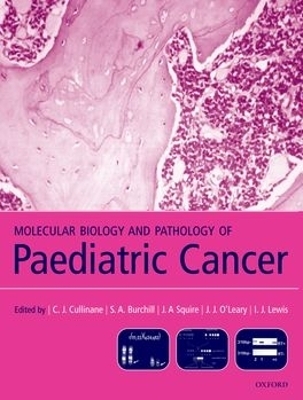
Molecular Biology and Pathology of Paediatric Cancer
Seiten
2003
Oxford University Press (Verlag)
978-0-19-263079-7 (ISBN)
Oxford University Press (Verlag)
978-0-19-263079-7 (ISBN)
The molecular study of paediatric tumours have contributed to our understanding of the pathogenesis of paediatric oncology. This is a review of molecular pathology and cytogenetic techniques, looking at the recent developments and their impact on our understanding of aetiology, clinical behaviour, diagnosis and management of paediatric cancer.
There has been an explosion of knowledge and enormous progress in the fundamental understanding of the biology of cancer in recent years. This has included the realisation that cancer occurs when normal cellular functions are disturbed leading to a malignant phenotype. Much research has focussed on understanding the types of disturbances that can occur, the contribution that these abnormalities can make to the development and behaviour of particular cancers and more recently, the recognition that these cellular and genetic abnormalities can provide rational targets for new therapeutic approaches. Information about the biology of cancers that occur in children has increased in parallel with these more general advances and this book is intended to provide a focus for readers who wish to have an understanding of our current state of knowledge.
A international group of editors and contributors provide guidelines on the molecular biology and pathology of paediatric oncology, aimed at clinicians and scientists working in the specialty who wish to understand current developments in molecular pathology as applied to their field. The book is a broad ranging review focusing on the impact of molecular and cytogenetic techniques on our understanding of the aetiology, clinical behaviour, diagnosis and management of paediatric cancer. The first section outlines the laboratory handling of tissue samples, theory and methodology of cytogenetic and molecular techniques and discusses predisposition syndromes. The second section highlights the application of cytogenetic and molecular methods in diagnosis and treatment of the major paediatric cancers.
There has been an explosion of knowledge and enormous progress in the fundamental understanding of the biology of cancer in recent years. This has included the realisation that cancer occurs when normal cellular functions are disturbed leading to a malignant phenotype. Much research has focussed on understanding the types of disturbances that can occur, the contribution that these abnormalities can make to the development and behaviour of particular cancers and more recently, the recognition that these cellular and genetic abnormalities can provide rational targets for new therapeutic approaches. Information about the biology of cancers that occur in children has increased in parallel with these more general advances and this book is intended to provide a focus for readers who wish to have an understanding of our current state of knowledge.
A international group of editors and contributors provide guidelines on the molecular biology and pathology of paediatric oncology, aimed at clinicians and scientists working in the specialty who wish to understand current developments in molecular pathology as applied to their field. The book is a broad ranging review focusing on the impact of molecular and cytogenetic techniques on our understanding of the aetiology, clinical behaviour, diagnosis and management of paediatric cancer. The first section outlines the laboratory handling of tissue samples, theory and methodology of cytogenetic and molecular techniques and discusses predisposition syndromes. The second section highlights the application of cytogenetic and molecular methods in diagnosis and treatment of the major paediatric cancers.
An introduction to children's cancer and the patient experience ; SECTION 1: METHODS AND CLINICAL APPLICATION ; 1. Cells, tissues and the diagnostic laboratory ; 2. Methods of genetic analysis applied to paediatric cancer ; 3. Blots, dots, amplification and sequencing ; 4. Familial and predisposition syndromes ; SECTION 2: CHILDHOOD CANCERS ; 5. Leukaemia ; 6. Lymphoma ; 7. Tumours of the central nervous system and eye ; 8. Neuroblastoma ; 9. Primitive neuroectodermal tumours ; 10. Rhabdomyosarcoma ; 11. Malignant soft tissue tumours of childhood ; 12. Pediatric renal neoplasms ; 13. Bone tumours (excluding Ewing's sarcoma) ; 14. Germ cell tumours ; 15. Liver tumours ; 16. Carcinoma ; Glossary of molecular terms
| Erscheint lt. Verlag | 13.11.2003 |
|---|---|
| Zusatzinfo | 8 pp colour plates; numerous black & white photographs, line illustrations and tables |
| Verlagsort | Oxford |
| Sprache | englisch |
| Maße | 196 x 253 mm |
| Gewicht | 887 g |
| Themenwelt | Medizinische Fachgebiete ► Innere Medizin ► Hämatologie |
| Medizin / Pharmazie ► Medizinische Fachgebiete ► Onkologie | |
| Medizin / Pharmazie ► Medizinische Fachgebiete ► Pädiatrie | |
| Studium ► 2. Studienabschnitt (Klinik) ► Pathologie | |
| ISBN-10 | 0-19-263079-2 / 0192630792 |
| ISBN-13 | 978-0-19-263079-7 / 9780192630797 |
| Zustand | Neuware |
| Haben Sie eine Frage zum Produkt? |
Mehr entdecken
aus dem Bereich
aus dem Bereich
Hämatologie und Internistische Onkologie
Buch | Softcover (2023)
ecomed-Storck GmbH (Verlag)
CHF 179,95
Buch | Softcover (2024)
Urban & Fischer in Elsevier (Verlag)
CHF 73,00


